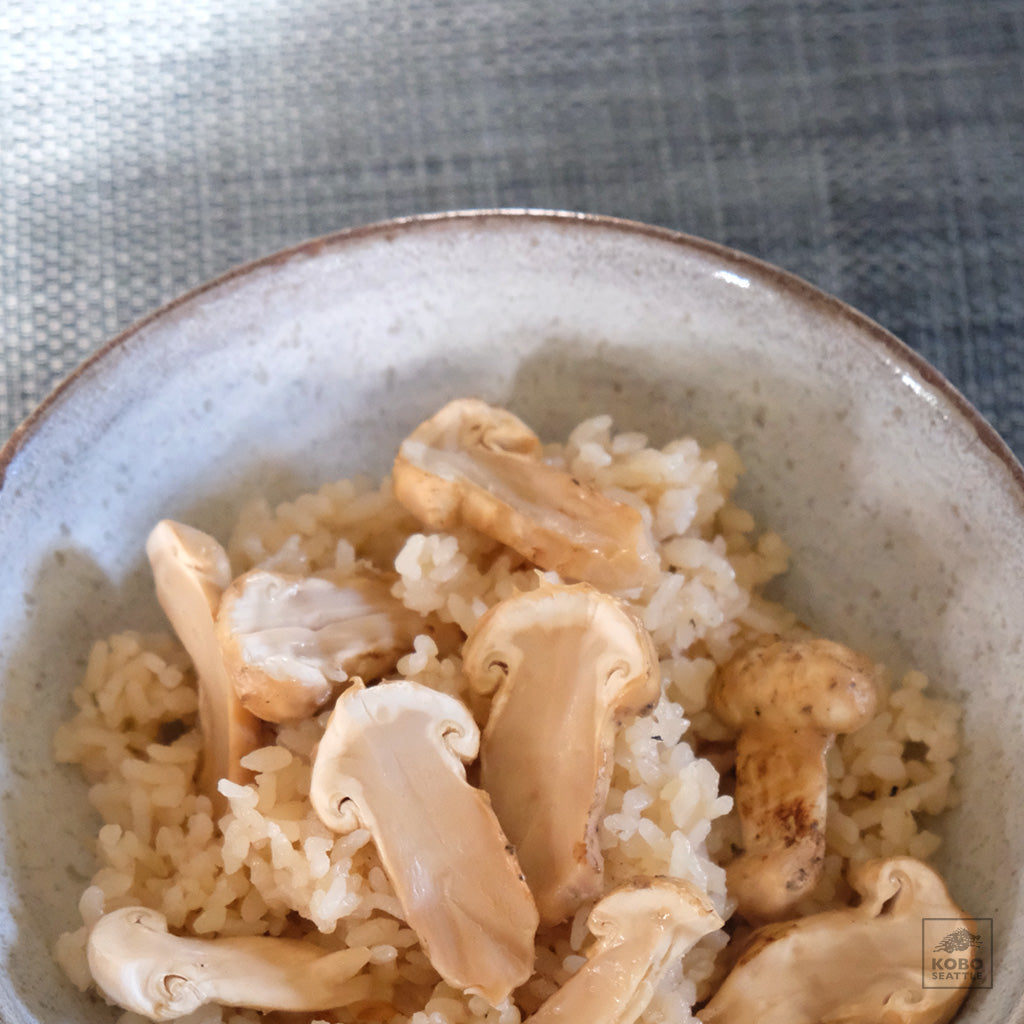KOBO Seattle | since 1995

[photo by Sakiko Fukuda 2020]
From our newsletter:
In the Pacific Northwest, we are lucky to find mushrooms through local foragers, friends, neighbors, farmers markets, specialty grocers, or to pick “incidental amounts” on our own. Matsutake is a mushroom that Japan and the Northwest have in common because of their tendency to grow in similar climates and coniferous forests under pines and firs.
As for cooking with matsutake, there are notes of pine, dirt and moss (remember that rainy walk through the forest, the path a spongy bed of pine needles). The flavor is not too subtle (ferny and earthy, a tad minty pine). The texture surprises: meaty, substantial, yet delicate (find yourself staring into the ether trying to find words to describe this dichotomy). And once your bowl is empty, the air seems lighter, and maybe for a split second, you’ve forgotten about quarantine life. Autumn is welcoming, beckoning, embracing your soft body, asking you to feel one with nature. Let the dance to the mushroom gods begin.
We asked a member of our staff, Sakiko, an avid cook, to tell us what she does with her first batch of Matsutake. We encourage you to try it if you have access to Matsutake. Here is her recipe. Itadakimasu!
Once a Year Special Rice a.k.a Matsutake Gohan
(about 4-6 servings for a couple of meals)
by Sakiko Fukuda
Ingredients:
For the Dashi (stock)
3-inch piece of kombu
A handful of bonito flakes (katsuobushi)
4 cups of water (1 cup = 180cc , or use cup that comes with your rice cooker)
(If you don't use all the dashi, keep the rest in the fridge)
For the Rice
Sushi rice (540cc / 3 rice cooker cups)
Dashi (540cc / 3 rice cooker cups)
1 1/2 Tablespoons soy sauce
1 Tablespoon sake (rice wine)
1/2 teaspoon salt (more to taste)
1/2 lb of matsutake
Make the dashi (stock) for your rice. Not only will you soak the rice in this dashi, it will be what you cook the rice with. This will add flavor like nobody’s business.
Soak a 3-inch piece of kombu (dried kelp) for at least two hours or overnight, in 4 cups of water. After soaking, transfer all to the stove and bring to a simmer. Right before it starts to boil, scoop the kombu out of the pot. Grab a handful of bonito flakes and put it in the pot on medium heat for about 5-minutes. Strain, and reserve the liquid gold. Let cool. Now you have dashi (stock).To the dashi, add soy sauce, sake, and salt. Taste and add more salt if needed.
Prepare rice. We recommend a rice cooker or donabe rice steamer if you have one. If using a rice cooker, measure rice in the cup that comes with it. Wash the rice until the water looks clear. Add the cooled dashi, filling to appropriate liquid line. Soak the rice for at least 2 hours or overnight.Clean the matsutake with a damp paper towel. It may take some doing, to remove the dirt and sand. Sakiko also recommends the back of a paring knife to scrape stubborn bits, or a brush. Trim the ends of the mushrooms. Then carefully, with your paring knife, make a little cut in the mushroom. We just need to make a little opening, to peel the mushroom lengthwise, like peeling a mozzarella stick.
Distribute the mushrooms evenly over the top. Do not mix.
Close the lid and press cook.
Once the rice is done, open the lid and mix it, scooping from the bottom to the top. Give it a good mix, then close the lid and let it sit for about 15 minutes before snarfing.
*Special note: Sakiko sometimes adds chicken to the recipe to make it more into a one-pot meal. Cut chicken breast into bite sized pieces and add to the rice cooker before the mushroom layer.
There are more matsutake gohan recipes and other dish ideas out there on the interwebs:
https://www.wildmushroomrecipes.org/browse-wild-mushroom-recipes/category-recipes/tricholoma-magnivelare-matsutake-pine-mushroom
https://www.mssf.org/cookbook/matsutake.html
https://norecipes.com/matsutake-mushroom-risotto-recipe/
https://langdoncook.com/category/matsutake/
https://toirokitchen.com/blogs/recipes/matsutake-mushroom-rice